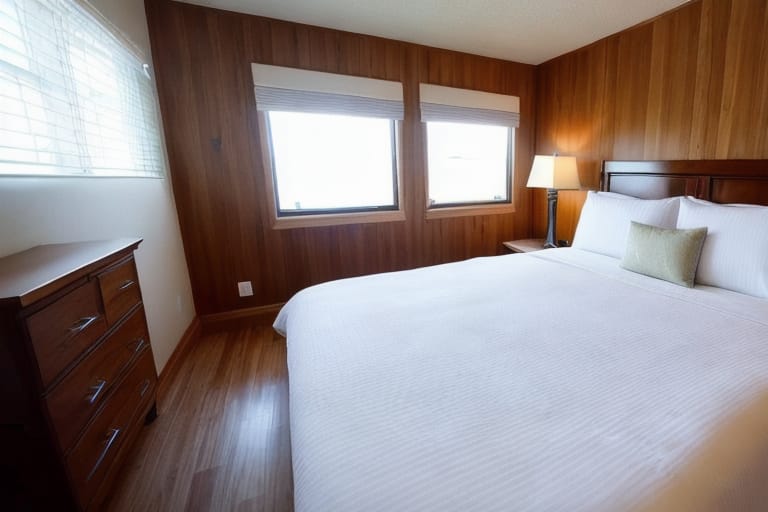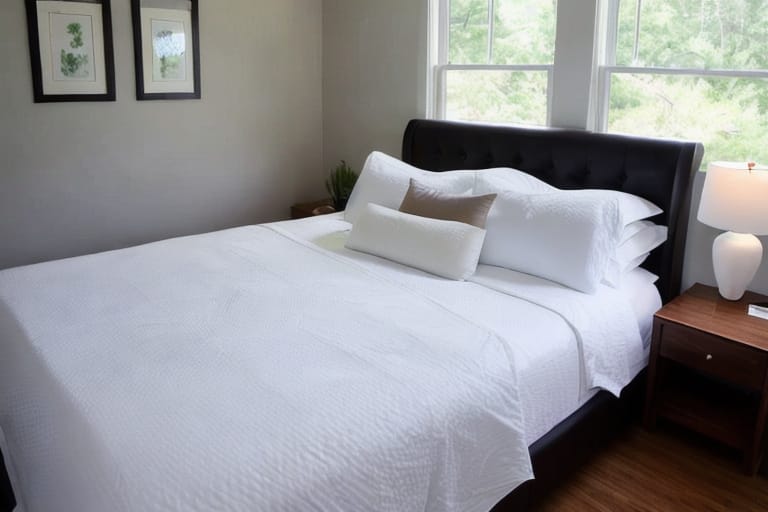Taking the chill out of winter nights is the entire point of owning a down comforter. You can bundle up under layers of blankets, but for consistent, all-night warmth you can’t beat a quality down-filled comforter.
What gives down that magical warmth? Why does it seem like some down comforters lose that wonderful insulation over time while others keep you toasty for years?
This guide will give you the full scoop so you can find (and maintain) the best comforter to be your ultra-cozy sleep partner.
How Down Keeps You Warm
A down comforter’s come-hither warmth starts with the filling.
Down is the fine, fluffy underlayer of feathers from ducks or geese. Down clusters trap heat effectively because they don’t fully compress. Air circulates freely in the spaces between the clusters, allowing your body heat to reflect back to you.
Synthetic fills like polyester are cheaper to produce than natural down. But those tightly packed fibers leave little room for warming air pockets to form.
Why Some Down Comforters Stop Keeping You Warm
When you invest in a down comforter you expect it to provide consistent warmth and comfort, winter after winter. But complaints abound from people who swear their formerly toasty down comforter seems to produce less heat over time.
What causes the reduced warmth? And what’s the best way to make sure your comforter continues insulating year after year?
Fill Power Fades Over Time
A down comforter’s warmth depends largely on fill power — the volume of space one ounce of down occupies in cubic inches. Higher fill-power numbers indicate better insulation.
Most quality down comforters have fill power between 600 and 900. Over time the clusters loosen and start to compress, reducing air circulation and warmth.
Higher fill-power down (800+) will retain warmth better over time.
Moisture and Mold Reduce Insulation
Exposure to moisture causes down to compress permanently. Wet down loses all ability to loft and hold in warmth.
Improper storage and washing mistakes often introduce damaging moisture. Mold and mildew may also start growing, causing further fill deterioration.
Best Practices for Retaining Down Warmth
Preserve your comforter’s fabulous warmth for years with proper care between uses.
- Allow the comforter to fully air out before storage
- Store loose in a breathable cotton case
- Wash infrequently in a front-loading machine only
Beyond that, look for sturdy construction with a high fill power (800+). Tightly-woven, high thread count fabric prevents fill escaping over years of use.
Finally — and this is key — always use a duvet cover to protect the comforter itself from body oils and spills.

Finding Your Perfect Down Comforter
The quest for dreamy sleep starts with finding your optimal comforter warmth. This depends on the climate where you live, the seasons you’ll use it, and your own personal temperature preferences.
Use this chart to identify your ideal warmth level:
| Climate | Season | Sleeper Type | Recommended Fill Weight |
|---|---|---|---|
| Temperate | Winter | Hot sleeper | Lightweight (<400 g) |
| Temperate | Winter | Average/cold sleeper | Mid-weight (400‒900 g) |
| Very cold | Year-round | Hot sleeper | Mid-weight (400‒900 g) |
| Very cold | Year-round | Average/cold sleeper | Heavy weight (>900 g) |
🛏️ Pro Tip: Look for baffle-box stitching that keeps fill evenly distributed for consistent comfort.
6 Top-Rated Down Comforters
Based on fill power, construction quality and owner satisfaction, here are exceptional down comforters delivering outstanding warmth and comfort.
1. Continental Bedding Premium Goose Down Comforter
- High 900 fill power
- 330 thread count
- Made in the USA
- Machine washable
- Baffled construction prevents shifting
- mid-weight and year-round warmth options
- Full range of sizes from Twin up to California King
- $169‒$329
2. Puredown Goose Down Comforter
- 750 fill power
- 300 thread count cotton cover
- Box stitch keeps fill in place
- 5-year warranty
- Machine washable
- $129‒$229
3. Luxurious 1200 Thread Count Goose Down Comforter
- Exceedingly fine 1200 thread count cover
- Sustainable European Goose down
- 800 fill power delivers year-round comfort
- Exterior duvet loops anchor your duvet cover
- LoftMax® baffle box design
- OEKO-TEX certification
- $179‒$399
4. Basic Beyond Goose Down Comforter
- 650 fill power
- 230 thread count microfiber exterior
- Double-needle stitching prevents leakage
- Affordable year-round warmth
- Queen size $69.99
5. Royal Hotel Goose Down Comforter
- 650 fill power
- 300 thread count 100% cotton cover
- Queen sized
- Baffle box design
- Machine wash cold, tumble dry low
- 100-night sleep trial
- $139.20
6. Buffy Cloud Down Alternative Comforter
- Made from recycled materials
- Provides warmth without animal products
- 800 fill power down alternative
- 300 thread count eucalyptus cover naturally resists dust mites
- One year warranty
- $179‒$239
🛏️ Sleep Tip: Add a down mattress topper like the Puredown 3D feather bed for additional insulation and 5-star hotel luxury.
Caring Properly for Down Durability
Follow these simple care and cleaning guidelines so you can snuggle blissfully under your down comforter for years to come:
- Always use a duvet cover to protect the down
- Surface spot-clean stains immediately
- Air out the comforter completely before storage
- Wash at a professional laundry every 2 years
- For DIY washing:
- Use a mild detergent for sensitive skin
- Front-loading wash cycle only
- Extra rinse cycle
- Low heat tumble dry with clean tennis balls
🛏️ Pro Tip: Add dryer balls to the machine to disrupt any remaining moisture and fully re-loft the down.

Wrapping Up Your Cozy Quest
The breathable warmth and peerless comfort of down still can’t be beat — when you choose the right fill power and properly care for your bedding investment.
Safeguard your comfort with knowledge of quality indicators, handling guidelines, and signs of wear. Follow the recommendations in this article and you’ll achieve heavenly hibernation all winter long.
Frequently Asked Questions
Does a down comforter need special cleaning?
Yes, down comforters require more delicate care than other bedding. Machine wash in front loaders only using a mild detergent. Be sure to use the delicate cycle and add extra rinse. Tumble dry low if machine drying. Adding dryer balls helps fully restore loft and warmth.
How often should I clean my down comforter?
Only wash a down comforter every 2-3 years, according to most manufacturers’ recommendations. This reduces moisture risks and fill deterioration. Use a removable duvet cover for protection and immediate spot cleaning when needed.
What is the warmest down comforter fill power?
Higher fill powers reflect increased insulation. Most quality down comforters range from 600-900 fill power. For ultra-warmth in cold climates, choose an 800+ fill power goose down comforter.
How do I make my down comforter fluffy again?
Lack of fluff means the baffles have collapsed, reducing insulation. Fully air out and dry the comforter first. Add two clean tennis balls to the dryer to help separate fill and restore loft. If that fails, have it professionally laundered.
How long does a quality down comforter last?
With proper care, storage, and cleaning, a quality down comforter will retain its fill power for warmth and last over 10 years. Higher thread counts (300+) and baffled construction increase durability so fill stays evenly distributed.
Why does my down comforter get flat spots?
Flat, empty spaces mean the fill has shifted. Quality baffle-box stitching prevents this. Add tennis balls in the dryer to help redisperse fill. Alternate which side you sleep on to reduce repeated compression in those spots.
At what temperature should I wash my down comforter?
Cold water is essential for cleaning down! Skip the hot water – it can destroy the feathers’ insulating capacity. Use the gentle or delicate cycle setting. Maximum water temperature 140°F to prevent fill deterioration. Tumble dry low.








